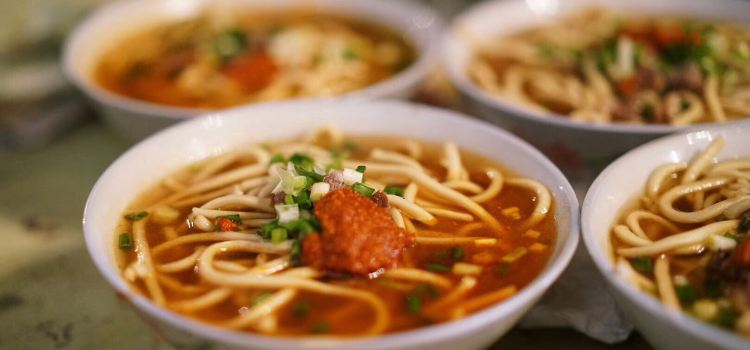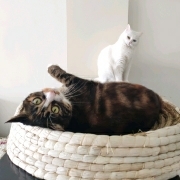Guangming Gangqiongtian Tea House
4.6/5504 Reviews
Barkhor Street/Jokhang Temple

Currently closed|Open tomorrow at 08:00
What travelers say:

Lao Guangming Teahouse really surprised me. There are so many people here. It should be the largest teahouse in Lhasa. 90% of the tea drinkers are locals, and there are tourists occasionally. You can find a seat by yourself, and sit wherever there is one. Basically, you share a table with Tibetan people. They are very friendly and it is very pleasant to chat with them. The environment is really ordinary, even a little dirty. Sweet tea requires a deposit of 10 yuan for a pot. When I left, I forgot to come back and talk to them and refunded it. The Tibetan brother told me that it is best to drink it cup by cup, and the taste is different each time. The potatoes are okay, and it smells good when I see other people eating Tibetan noodles. You can come and sit, you can really feel their happiness.
More
Reviews of Guangming Gangqiongtian Tea House
Some reviews may have been translated by Google Translate
4.6/5Outstanding
All (504)
Latest
Photo reviews (105)
Positive reviews (72)
Lao Guangming Teahouse really surprised me. There are so many people here. It should be the largest teahouse in Lhasa. 90% of the tea drinkers are locals, and there are tourists occasionally. You can find a seat by yourself, and sit wherever there is one. Basically, you share a table with Tibetan people. They are very friendly and it is very pleasant to chat with them. The environment is really ordinary, even a little dirty. Sweet tea requires a deposit of 10 yuan for a pot. When I left, I forgot to come back and talk to them and refunded it. The Tibetan brother told me that it is best to drink it cup by cup, and the taste is different each time. The potatoes are okay, and it smells good when I see other people eating Tibetan noodles. You can come and sit, you can really feel their happiness.
Lao Guangming Gangqiong Sweet Teahouse is a time-honored sweet teahouse in Lhasa. It is a large place with many people. Sweet tea is like bubble milk tea without pearls, and you won't get used to it. We ate freshly fried potatoes and fried noodles here, drank several cups of sweet tea, and solved our breakfast and lunch together.
Tibetan butter tea. First, boil tea leaves or brick tea in water for a long time to make a thick juice, then pour the tea into "Dongmo", then add butter and salt, and vigorously pump the "Jialuo" up and down dozens of times to mix the oil and tea, then pour it into the pot and heat it, it will become a fragrant and delicious butter tea.
Guangminggang Qiongtian Teahouse, the largest and oldest teahouse in Lhasa, pulls aside the inconspicuous old-fashioned cloth curtain and hundreds of people come into view, which is the laziest time in Lhasa. This is the gathering place for old Lhasa people, literary youths, and Tibetan drifters. As long as there is change and an empty cup on the table, someone will come to pour sweet tea. It costs 80 cents a cup, and a few dollars for a pot, which can consume an entire afternoon. Listening to the Tibetan language that you don’t understand and watching all kinds of people coming and going, this is the most authentic Lhasa smell!
#诗和远方,藏和天堂#15.09 12 days in Tibet, Lhasa The most appetizing sweet tea among all the sweet teas I drank along the way in Tibet The taste is closer to Hong Kong-style milk tea It tastes good and only costs 70 cents per cup It's really a bargain Environment-wise, if you want to experience the local life of Tibetans Then this is definitely the place to come There is a large space inside with many Tibetans sitting Everyone sits together and drinks sweet tea There are mostly tourists outside Recommended to friends who come to Lhasa
Guangminggang Qiong Sweet Teahouse. A sweet teahouse recommended by many guides. Some people say that the habit of drinking sweet tea in Tibet comes from the British afternoon tea. The teahouse is in a good location, located on the main street next to the Jokhang Temple. It should be the largest teahouse with the most conspicuous facade. It was afternoon tea time, and the hall was full of people, talking in groups of three or two, with Tibetan and Chinese mixed together, and some people played games similar to dice. A cup of sweet tea costs 70 cents, and two pounds of sweet tea costs 8 yuan, which is a pot. Take your own cup and sit down, long bench. There are a lot of change scattered on the long table. The big sister in a white coat patrols the table, fills a cup, and takes 70 cents, one cup after another, with a bowl of Tibetan noodles, a plate of fried potatoes, and a full afternoon tea! The Tibetan noodles have a slightly hard texture. I don’t know if it is related to the high altitude of the plateau and the undercooked. The soup is made of yak bones, fragrant!
The entrance of Guangminggang Qiongtian Teahouse is Danjielin Road, the main passage to Jokhang Temple. The business is prosperous, and the price of the teahouse is authentic. Although the internal environment is very ordinary, it is just a simple collective canteen, but this teahouse is the most famous and has the largest flow of people in the local area. The door of the sweet teahouse is not big, it is very Tibetan style. After entering the door, the hall inside is very spacious, with several rows of long low tables, very Tibetan style. In fact, this hall is just a roof on the courtyard. The teahouse gathers people of all identities. It is simply overcrowded. Tibetans here are like Chengdu people in teahouses, staying for half a day. This is the most popular place in Tibet. Of course, it is also a good place for us tourists to experience folk customs. Teams of tourists come in from time to time. It is said that occasionally many foreigners will come here to drink tea. Whether you can understand Tibetan or not, here, a cup of sweet tea for 70 cents can be used for an afternoon. The sweet teahouse also provides Tibetan snacks such as Tibetan noodles, which are not expensive. If you are used to it, you can try it. After passing through the hall, there is the inner room, which also has several rooms. In fact, it is also a hall, but it is a formal room without a single door. There are also several long tables. The process of drinking tea in the teahouse is very special, and of course very free. When we entered, we sat on the stools and waited stupidly, thinking that someone would come to ask you what you want to drink or eat. As a result, no one paid attention to us after waiting for a long time. The Tibetans drinking tea next to us saw our stupidity and gestured for me to go to the bar. I went there and found out that everything here is self-service. You go to the house to get a glass cup and put it on the table in front of you, and then put the change for drinking tea next to the cup (if you don’t have change, go to the bar to change it yourself). A cup of sweet tea is 70 cents (you can also order a pot of 8 yuan and pour it yourself. First go to the bar to pay a deposit of 20 yuan to exchange the brand and get a thermos. We chose this method), and then wait for the waiter in a white coat to come and add tea for you. The waiter pours tea and collects money in order. It’s useless if you want to hurry up. After the waiter pours tea for you, he will take the appropriate amount from the change on the table. When there is no change next to your teacup, the waiter will not refill your cup. It’s very interesting. There is no language in the whole process, only a knowing smile. When drinking tea, you will find Tibetans drinking tea, eating noodles, playing cards, chatting, and living a very comfortable life. It is lively but not noisy here. This kind of leisure is beyond the reach of those of us who are used to the fast-paced life in the city. Although the environment is poor and the noise is a bit noisy, what you enjoy here is the city life of Tibetans in this environment. In fact, Tibetans come here not only to drink sweet tea, but also provide simple Tibetan meals such as Tibetan noodles. It seems that they also come here to eat on weekdays.